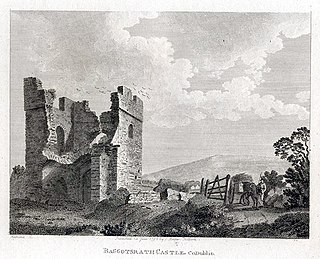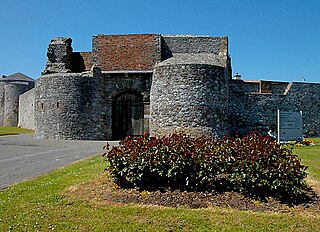Walter de Thornbury was an English-born statesman and cleric in 14th century Ireland who held the office of Lord Chancellor of Ireland. His efforts to secure confirmation of his election as Archbishop of Dublin were cut short by his death in a shipwreck.

Sir John Wogan or John de Wogan, styled lord of Picton was a Cambro-Norman judge who served as Justiciar of Ireland from 1295 to 1313.
Sir Elias de Asshebournham, or Ellis de Ashbourne (c.1290-1357/8) was an Irish judge who held the office of Lord Chief Justice of Ireland, and fought a long battle with a rival candidate, Thomas Louth, to retain it. Despite frequent allegations of corruption, and a reputation for violence, for many years he retained the confidence of the English Crown, although he also suffered periods of imprisonment.
John de Grauntsete or Grantsete (or John of Grantchester) (c. 1270 – c. 1350) was an English judge who lived in fourteenth-century Ireland. We know more about him than we do about any other contemporary Irish judge, and from the surviving information we can form some idea of the lifestyle of an Irish judge in his time. He sat in turn in each of the Irish Courts of common law, and uniquely he is known to have appeared in Court as an advocate even after he became a judge.
John Gernoun, or Gernon was an Irish landowner, soldier and judge who held office as Serjeant-at-law (Ireland) and Chief Justice of the Irish Common Pleas. He gave good service to the Crown during the Scottish Invasion of 1315-18, but as a judge, he was accused of injustice.
Geoffrey de Morton was a wealthy merchant and shipowner in early fourteenth-century Dublin who served as Mayor of Dublin in 1303.

John Penros or Penrose was a Cornish lawyer and judge who held high office as Lord Chief Justice of Ireland, and subsequently served as a High Court judge in England and Wales. Despite his professional eminence, he was guilty of "an extraordinary career of crime" which stretched over nearly thirty years. When the charges against him were eventually proven, he was removed from the Bench.

Thomas de Dent, Thomas Dyvelyn, Thomas Denton, or Thomas of Dublin was an English-born cleric and judge who held high office in Ireland during the reign of King Edward III, and was praised as a diligent and hard-working Crown official, who damaged his health through overwork.
Richard le Blond was an Irish lawyer and judge of the early fourteenth century. After serving for many years as Serjeant-at-law (Ireland) he was rewarded for his services to the English Crown with a seat on the Court of Common Pleas (Ireland).
William of Bardfield, William de Berdefeld or William de Bardesfeld was an English-born lawyer of the late thirteenth and early fourteenth century who enjoyed a successful legal career in England before moving to Ireland, where he was successively Serjeant-at-law (Ireland), justice of the Court of Common Pleas (Ireland), and justice of the Court of the Justiciar of Ireland.
John de Ponz, also called John de Ponte, John Savan, or John of Bridgwater (c.1248–1307) was an English-born administrator, lawyer and judge in the reign of King Edward I. He served in the Royal Household in England for several years before moving to Ireland, where he practised in the Royal Courts as the King's Serjeant-at-law (Ireland). He later served as a justice in eyre, and then as a justice of the Court of Common Pleas (Ireland). He was a gifted lawyer, but as a judge was accused of acting unjustly. A case he heard in Kilkenny in 1302 can be seen as a precursor of the Kilkenny Witchcraft Trials of 1324, and involved several of the main actors in the Trials.
Sir William le Deveneys was a Crown administrator and judge in late thirteenth and early fourteenth century Ireland, who served very briefly as Chief Justice of the Irish Common Pleas.
Walter de Cusack was an Anglo-Irish judge, magnate and military commander of the fourteenth century.
Hugh Canoun, or Hugh Canon was an English-born judge in early fourteenth-century Ireland. He was a justice of the Court of Common Pleas (Ireland) and served as Deputy Justiciar of Ireland. As a judge he was praised for his good and faithful service to the English Crown, and as a lawyer he was known as "a man very knowledgeable about all the King's business". On the other hand, his loyalty to the Crown during the Scottish Invasion of Ireland in 1315-18 was said to be extremely doubtful, although he was saved from disgrace by his influential connections. He was murdered by Andrew de Bermingham of Athenry in 1317/18, during the last months of the Bruce Invasion, in the course of a private feud, of which little is known.

Sir Robert Bagod was a judge, Crown servant and military commander in fourteenth-century Ireland.

Sir Walter de la Haye, or de Haye was an English-born statesman and judge in Ireland of the late thirteenth and early fourteenth centuries, who served for many years as Sheriff of County Waterford and as Chief Escheator of Ireland, and briefly as Justiciar of Ireland. He was a conscientious official who was held in high regard by the English Crown, which protected him from accusations of corruption. He was also accused of unduly high-handed behaviour as Escheator, in taking property into the King's hands for insufficient cause. He became a substantial landowner in two Irish counties. He had children, but his descendants seem to have died out within a couple of generations.
William Alysaundre was an Irish judge and Crown official in the reigns of King Edward I of England and his son.

Sir John de Fressingfield (c.1260-c.1323) was an English knight, judge, diplomat and Privy Councillor, much of whose career was spent in Ireland. Though he is almost entirely forgotten now, he was a figure of some importance in English and Irish public life in the first 20 years of the fourteenth century. He also held judicial office in Jersey and Guernsey.
William fitz Roger was an Anglo-Norman senior cleric, judge and Crown official in late thirteenth-century Lordship of Ireland. He was Prior of the Irish House of the Knights Hospitallers at Kilmainham, and served as a Privy Councillor and as a justice in eyre. He led several military expeditions, but was a notoriously incompetent commander, whose campaigns invariably ended in failure. He served as Deputy Justiciar in 1284-5, and as acting Justiciar of Ireland in 1294.
Sir Walter l'Enfant the younger, lord of Carnalway, County Kildare was an Irish judge and landowner.